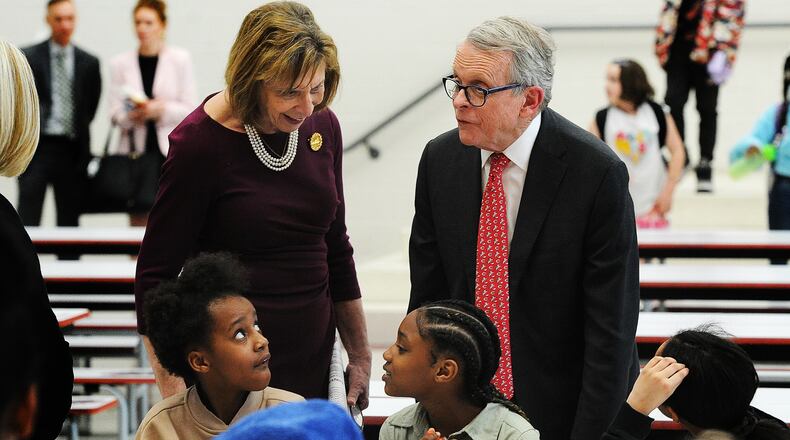This school year, Northridge fully implemented a new science of reading curriculum, Superintendent Dave Jackson said. Previously, the district used a whole language approach.
In curriculums based in the science of reading, the emphasis is on phonics and teaching skills to identify words. Whole language focuses on using speaking, writing and sounds to teach children to read, whereas the science of reading uses neuroscience.
Jackson said the district started this school year with 28% of kindergarten students on track for reading, and as of March 13, 73% of those students were on track. In the 2018-2019 school year, by the end of the school year, 46% of kindergarten students were on track.
At Tecumseh Local Schools, they use the science of reading because the “research is clear about what matters to teach in early literacy instruction,” said Superintendent Paula Crew.
Administrators, teachers and staff have increased their learning in phonological awareness and phonics over the last few years.
“It is important that we continue professional development surrounding the science of reading to support staff in their efforts to educate students using the most effective strategies,” Crew said, who said the program, “is proven to help students become critical readers and efficient writers.”
Northeastern Local Schools also uses a science-based approach to reading, teaching phonics and awareness as well as training staff.
“We believe that phonics instruction and the elements of reading instruction should be skill-based and not dependent on the student’s ability to correctly guess answers or memorize words,” said Beverly Walkden, curriculum director.
Mechanicsburg Superintendent Danielle Prohaska said the district also already had begun focusing on the science of reading and developing teaching practices aligned with that, specifically at Dohron Wilson Elementary.
“We made this shift at the primary grade levels to support specific and targeted instruction based on student needs in order to build a strong foundation of literacy in all students,” Prohaska said.
Statewide, literacy achievement is down. In the 2021-22 school year, 59.8% of third grade students tested proficient in reading, while in the 2018-19 school year — the last one before the pandemic — 66.7% of third-graders tested proficient in reading. Proficient means that a student can read the words and understand what they mean.
Jackson said DeWine was at Northridge to see what his budget proposal would do.
“It means a lot, to be a model for what the governor wants to do across the state of Ohio,” Jackson said.
Urbana is in the process of moving from a whole language approach to the science of reading methods, according to Superintendent Charles Thiel. It started about three years ago when the district identified a weakness in “the lack of systematic instruction in phonics and phonemic awareness.”
Staff from Kindergarten through second grade began a science based reading program, and a district committee last year studied programs and recommended all elementary staff receive training for the science of reading. Thiel said the next phase is reviewing literacy curriculums and implementing that.
Graham Local Schools is in a similar situation as Urbana, getting training for the elementary teachers and researching programs.
“We are ... looking very closely at what we have been doing that is working and isn’t working, and we are talking with comrades in similar districts to investigate what they are doing and the results of their work,” said Stephanie Gray-Johnson, Graham’s director of teaching and learning.
With many districts following the science of reading, Clark-Shawnee is one that uses both approaches and individualizes instruction based on student needs.
“All of the approaches have evidence-based research supporting them,” said Superintendent Brian Kuhn. “We know the landscape is shifting, we know new and ongoing research continues to emerge, and we are adjusting our instruction accordingly to address student learning using the best practices that are available to us.”
While many districts, like Northridge, have recently flipped their curriculums, especially following the COVID-19 pandemic and the drop in literacy achievement, there are still those who oppose DeWine’s proposal.
Many teachers were trained in whole language and have to relearn how to teach with the science-based curriculums. While many local schools have already switched curriculums to science of reading, those who have not yet done so would need to purchase new books and retrain their teachers.
Ohio teachers’ unions have also pushed back on the proposal, mostly to ask for a voice for teachers at the table and to figure out what the potential impact on teachers could be.
In the second-grade classroom DeWine visited on Thursday, a second-grade teacher worked alongside an intervention specialist.
“At Northridge, they are doing an absolutely phenomenal job,” DeWine said after his visit. “If you look at where they were a few years ago, compared to where they are today, they’ve just gone straight up.”
On Thursday, DeWine also signed an executive order to create the Governor’s Literacy Challenge to improve reading proficiency for Ohio’s children.


